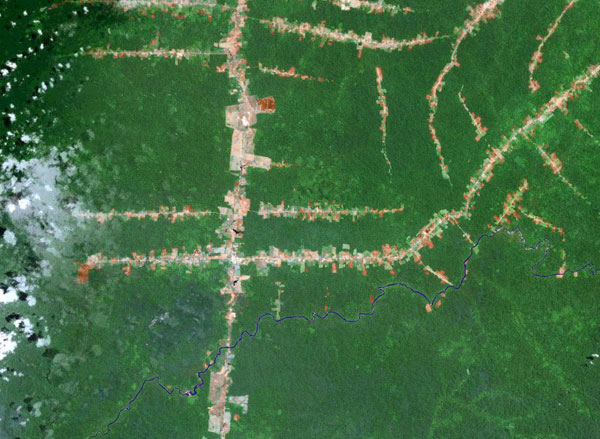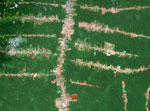
Roads radiating out from a highway in the Brazilian Amazon. Courtesy of NASA
A group of prominent scientists chose to mark the second International Day of Forests by urging the world to support an initiative that aims keep wild areas free of roads.
Roadfree, an initiative led by Member of the European Parliament Kriton Arsenis, has been growing in prominence over the past year, gaining supporters ranging from indigenous rights leaders to deep ecologists. Now the Alliance of Leading Environmental Researchers and Thinkers (ALERT), a group of prominent conservation scientists, has thrown its weight behind the concept.
“It’s reached crisis proportions,” said William Laurance, a professor at James Cook University in Australia and the director of ALERT. “Whether you’re talking about the Amazon, Sumatra, Siberia or the Congo, there’s hardly a wilderness area left that isn’t under assault from new roads. Those roads usually open a Pandora’s Box of environmental problems—such as illegal fires, deforestation, hunting and gold mining.”
“It’s become one of the biggest environmental worries of this century,” said Thomas Lovejoy, an ecologist who has served as an environmental advisor to three U.S. presidents. “Roads are driving a great deal of habitat loss and fragmentation around the world.”
According to the group, 95 percent of forest loss occurs within 50 km of a road, which is a dire prospect given projected road expansion — 90 percent of which will be in countries with the highest levels of biodiversity — in coming decades.
“It’s been estimated that we’ll have another 25 million kilometers of paved roads by 2050—enough to encircle the Earth more than 600 times,” said Lovejoy.

Logging road in the Pacific Northwest of the United States. Photo by Rhett A. Butler
While ALERT acknowledges the role roads play in economic development, it is urging policymakers and financiers to consider the considerable environmental costs of building roads through intact ecosystems.
“Once a new road goes in, that’s often the beginning of the end,” said Corey Bradshaw, a professor at the University of Adelaide. “The only way to ensure the survival of wilderness and biodiversity is to keep roads out altogether—by avoiding the first cut.”
Roads are often built initially for logging, mining, and energy development. After valuable timber is harvested, minerals extracted, and oil and gas shipped away, the next wave of people arrive. These may be land speculators, informal loggers and miners, slash-and-burn farmers, industrial farmers and plantation developers, or commercial poachers. Forests are rapidly cleared, often illegally and without generating much in the way of revenue for the state, while wiping out wildlife, generating carbon emissions, degrading important ecosystem services, and putting traditional livelihoods at risk.

Logging road in Borneo. Photo by Rhett A. Butler. “Road building, associated with industrial logging in the tropics, is almost always the first step towards destruction of forests,” said Barbara Zimmerman, Director of the Kayapo Project with the International Conservation Fund of Canada. “High-value timber species are completely extirpated, leading to degradation of primary forest to a state from which it is impossible to recover or at best, its regeneration is severely depressed.”
Kriton Arsenis, Roadfree’s founder, says that limiting road construction in intact forests would be an effective way to meet several environmental goals.
“Keeping our last intact forests free of roads is a cost-efficient way to protect the climate, halt biodiversity loss and keep illegal traffickers at bay”, said Kriton Arsenis in a statement.
“Intact forests store vast amounts of carbon, most of which is contained in large, old trees,” added Sean Foley, Chairman of The Samdhana Institute. “Keeping these forests intact and free of roads not only prevents dangerous carbon dioxide emissions, it also preserves the homes and livelihoods of tens of millions of indigenous peoples around the world, and helps them adapt to a rapidly changing climate.”
Disclosure: author Rhett Butler is an operational advisor to ALERT, but had no role in ALERT’s press release on this issue.
Related articles

(11/12/2013) In August 2012, professional photographers Ivan Kashinsky and Karla Gachet were on assignment for National Geographic in Yasuní National Park, home to arguably the most biodiverse rainforest in the world. While there, they happened to take an aerial shoot above an area known as Block 31 (see Map), a controversial oil concession located in the heart of the park, at the precise moment that the national oil company, Petroamazonas, was secretly building a new oil access road.
50,000 km of roads built across Brazilian Amazon in 3 years
(10/29/2013) Roads are rapidly expanding across the Brazilian Amazon opening up once remote rainforests to loggers, miners, ranchers, farmers, and land speculators, finds a new study published in the journal Regional Environmental Change.
Roads could help protect the environment rather than destroy it, argues Nature paper

(03/22/2013) Rapidly expanding road networks are causing large-scale damage to forests but proper infrastructure planning and implementation could actually turn them into a net positive for the environment, argue researchers writing in the journal Nature. William Laurance and Andrew Balmford highlight the severe environmental impacts of roads in wilderness areas, including fostering illegal logging, poaching, colonization, and land speculation.
Roads are enablers of rainforest destruction

(09/24/2009) Chainsaws, bulldozers, and fires are tools of rainforest destruction, but roads are enablers. Roads link resources to markets, enabling loggers, farmers, ranchers, miners, and land speculators to convert remote forests into economic opportunities. But the ecological cost is high: 95 percent of deforestation in the Brazilian Amazon occurs within 50-kilometers of a road; in Africa, where logging roads are rapidly expanding across the Congo basin, the bulk of bushmeat hunting occurs near roads. In Laos and Sumatra, roads are opening last remnants of intact forests to logging, poaching, and plantation development. But roads also cause subtler impacts, fragmenting habitats, altering microclimates, creating highways for invasive species, blocking movement of wildlife, and claiming animals as roadkill. A new paper, published in Trends in Evolution and Ecology, reviews these and other impacts of roads on rainforests. Its conclusions don’t bode well for the future of forests.